FNAF: Mega Pizzaplex
Introduction
Project Description
Given a 3D model of the new Computer Science building in construction at the University of Illinois Chicago, this project focuses on providing the user with an immersive Virtual Reality (VR) experience at building-scale. Loosely modeled after the Mega Pizzaplex from the video game Five Nights at Freddy's: Security Breach (2021), the user can explore the building and interact with objects within reach through the use of a Virtual Reality headset.

As shown in the image comparison above, the Golden Freddy statue found in the game has been included in the project to make it resemble the Mega Pizzaplex.
Videos
New Video
Old Video
How To Use the Application
In order to use the application, one must first download the project from GitHub and install the necessary software. Assuming that the steps described in the section titled "Instructions to Build and Run" have been followed, the user can now explore the Security Breach-themed building. The user can pick up and toss ten items which are a Fazer Blaster, a flashlight, a noise maker, a paper cup, a pizza, a cupcake, a wet floor bot, a puppet mask, a stroller, and a Bonnie plush. They can also interact with objects that produce duplicates. Pressing the buttons of the oven results in duplicates of Mr. Cupcake and a pizza. Pressing the button on the side of the flashlight charger dispenses flashlights. Lastly, spinning the handle of the prize box spawns Bonnie plushes. Additionally, the user can pull levers to change aspects of the scene. One lever changes Sundrop to Moondrop while the other triggers the lights and theme music of the hidden stage. In order to better traverse the space, the user can teleport to six locations using the charging stations.
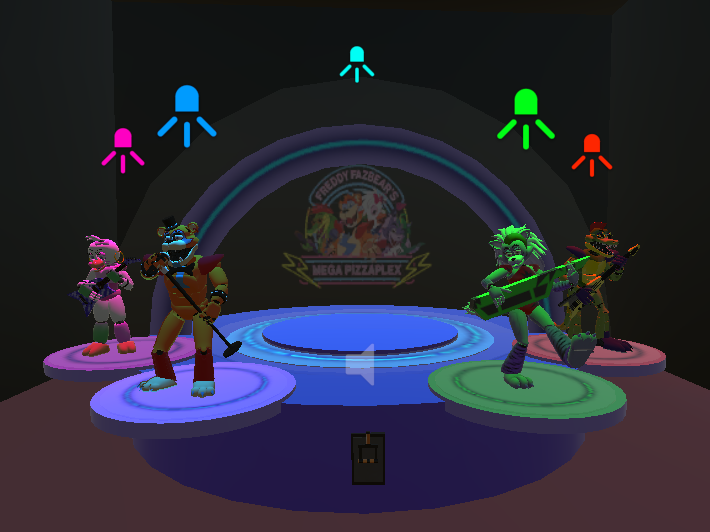
Instructions to Build and Run
Downloading Project from GitHub
To begin, download the project from the following link by clicking on the green button that says "Code" and selecting "Download ZIP":
Group4.Project3
Installing Unity and Unity Hub
Extract the ZIP file as needed. The next step is to install Unity. To do so, go to https://unity.com and select the blue "Get Started" button at the top. Select the "Individual" tab and click on another blue "Get started" button underneath "Personal". Download Unity Hub for your preferred platform. Install Unity Hub which will host your Unity projects. In Unity Hub, click on "Installs" then "Install Editor" to install a new Unity version. This project uses version 2021.3.6f1. Visit the download archive at https://unity3d.com/get-unity/download/archive and select Unity 2021.x to find the correct version. Install using Unity Hub. It should then appear there. Open the project by pressing the "Open" button in "Projects". While not required to download and install, it should be noted that the project makes use of VRTK version 4.
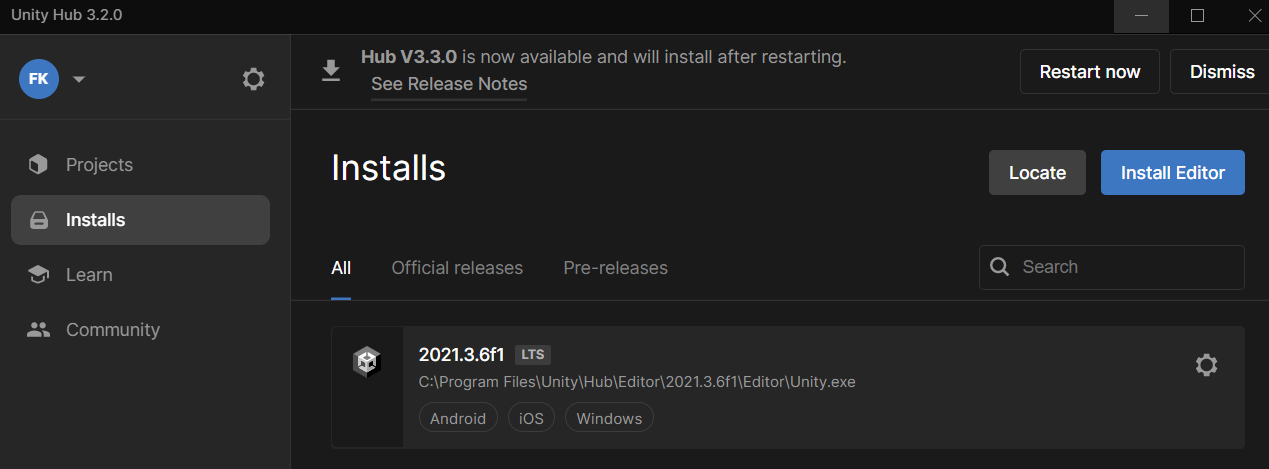
Building and Running on the Quest
Connect the Quest headset to the laptop using a suitable USB cable. Put on the Quest headset and use the controllers to tell the Quest to accept the PC connection and always allow that connection. Make sure developer mode is on. Click on the Quick Settings menu on the left side of the thin menu, then click on the settings menu on the upper right. Next, scroll down in the menu on the left to Developer and turn on the USB Connection Dialog.
In the hierarchy of the Unity project, make sure CameraRigs.UnityXRPluginFramework is enabled while CameraRigs.SpatialSimulator is disabled. Under Unity Build Settings, make sure you are building for the Android Platform and the Quest connected shows up under the Run Device list of compatible connected devices. If it does not show up, unplug and re-plug the USB cable, then tell the Quest to accept the connection to the laptop again. Save the project and restart Unity.
Click on Build and Run. It should take about 5 to 10 minutes for Unity to convert all the assets to a form suitable for the Quest. Disconnect the USB cable from the Quest, put on the Quest headset, and grab the two controllers. The app should start automatically.
Included Assets
Downloaded Assets - 3D Models
The following is a list of all the 3D models that have been downloaded from the internet as well as their sources and credits. Included are short descriptions of how each relate to the requirements of the project. In the images of this section, the red numbers represent the downloaded 3D models.
- Tables: The four tables help decorate the space, as they are modeled after the tables in the game. They can be found here: https://sketchfab.com/3d-models/fnaf-table-5449d541f2954577a6f3e983fb2d00a5
- Stroller: The stroller serves as the first of ten items that can be picked up. It can be found here: https://sketchfab.com/3d-models/freddys-stroller-fnaf-security-breach-ea0b22bb25454f24b1ea9dd6d2e18e83
- Playground: The playground is the first of eight objects that produce sound. It is also the first of four to be larger than a human. It can be found here: https://sketchfab.com/3d-models/slide-playground-e59c8559ba42463881732790dcbfbb3c
- Fazer Blaster: The Fazer Blaster serves as the second of ten items that can be picked up. It is also the first of four to be smaller than a human. It can be found here: https://sketchfab.com/3d-models/fazer-blaster-9589f6a4e4864b15985b8090ca33dcf4
- Noise Maker: Three noise makers have been placed in the scene and serve as the third of ten items that can be picked up. They can be found here: https://sketchfab.com/3d-models/daycare-noisemakervariant1-fnafsb-7ba74f329e3f4d10ae90c29f14f786dc
- Flashlight Charger: The flashlight charger serves as the first of four interactive objects that spawn duplicates. Pressing its button spawns flashlights. It can be found here: https://sketchfab.com/3d-models/five-nights-at-freddys-security-breach-charger-c15ce2f06f7b4d83be50925bf8d4e3aa
- Golden Freddy Statue: The Golden Freddy statue serves as the second of four objects that are larger than a human. It can be found here:
- Sundrop: Sundrop serves as the first of four models to have an animation. He is also the second of eight to make sound. He can be found here: https://sketchfab.com/3d-models/fnaf-security-breach-sun-all-animations-a7cf3abb5ac94324bb88dd07a6d78f83
- Moondrop: Like Sundrop, Moondrop is the second of four to have an animation. He is also the third of eight to make sound. He can be found here: https://sketchfab.com/3d-models/moondrop-read-description-security-breach-ccd4b4bd7756417fb70a0a237692e236
- Balloon Boy: Balloon Boy is the third of four models to have an animation. He was intended as the first of two models to move around the scene. He is the second of four to be smaller than a human. He can be found here: https://sketchfab.com/3d-models/balloon-boy-jumpscare-da956b130973413fa3d0b98a25cbcf90
- Palm Trees: The palm trees serve to decorate the space. They can be found here: https://sketchfab.com/3d-models/palm-tree-95cd1a77789241ee82a960bad5dfe809
- DJ Music Man: The fourth of four models to have an animation. The third of four models larger than a human. The fourth of eight to make sound. He can be found here: https://sketchfab.com/3d-models/dj-music-man-b48e9324f043473396c6a670dc8c2781
- Oven: The oven serves as the second and third of four interactive objects to produce duplicates. Pressing the buttons produce pizzas and Mr. Cupcakes. It is also the fifth of eight to make sound. It can be found here: https://sketchfab.com/3d-models/cartoon-oven-ba6bdb08360b485ea392d85d9b1b729a
- Wet Floor Bot: Serves as the fourth of ten items that can be picked up. Is also the third of four objects smaller than a human. It can be found here: https://sketchfab.com/3d-models/fnaf-security-breach-wet-floor-bot-59115a82905e478a96e91a1a46b69f89
- Mini Music Man: Fourth of four objects smaller than a human. Fifth of four models to have an animation. Is the second of two moving objects. He can be found here: https://sketchfab.com/3d-models/mini-music-man-security-breach-d26019ffc9c0419e84e38e82a622593d
- Save File Station: Hosts a flat model which is a video player. It serves as the sixth of eight to make sound. It can be found here: https://sketchfab.com/3d-models/fnaf-security-breach-saved-station-1ebf24f9bf444719a10d40ee0c28538d
- Glamrock Freddy: He can be found here: https://sketchfab.com/3d-models/glamrock-freddy-7d63e08eb93e43f49044c408c26589b5
- Montgomery Gator: He can be found here: https://sketchfab.com/3d-models/montgomery-gator-0c2a4afec1e84f05a5c80723fee1d8a5
- Roxanne Wolf: She can be found here: https://sketchfab.com/3d-models/roxanne-wolf-security-breach-0f47977bb2f7458fa56ac4e2c373ada9
- Glamrock Chica: She can be found here: https://sketchfab.com/3d-models/glamrock-chica-c621e7b79d1843028dfbe226f99f2909
- Bonnie Plush: The fifth of ten items that can be picked up. Fifth of four to be smaller than a human. It can be found here: https://sketchfab.com/3d-models/bonnie-plush-844ee9dfdc3e469d9ad13e9839236976
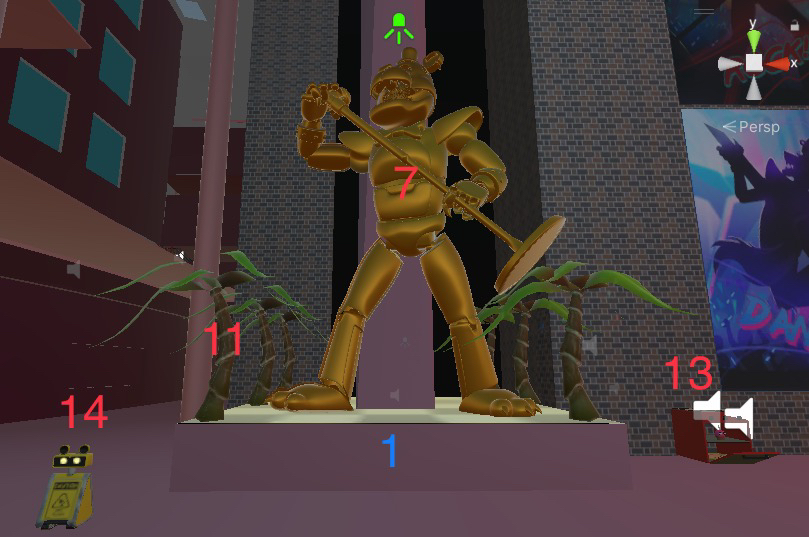
The Golden Freddy statue as seen on the first floor.
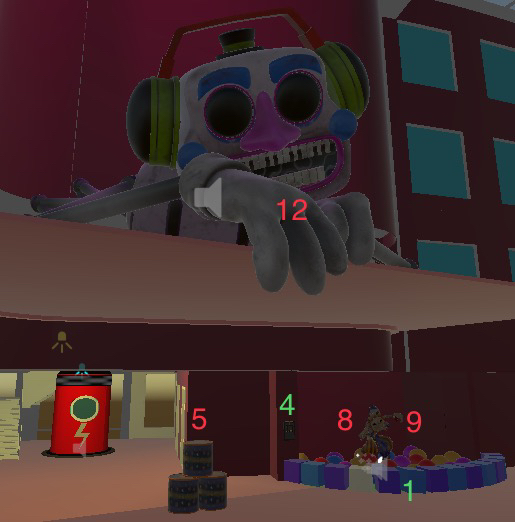
A brief glimpse of the second and third floors. The second floor is modeled after the game's daycare and the third floor hosts DJ Music Man.
Downloaded Assets - Sounds
The following is a list of all the sounds that have been downloaded from the internet as well as their sources and credits. Included are short descriptions of how each relate to the requirements of the project.
- Stage: The theme music of the stage serves as the first of two ambient sounds or pieces of music. It can be found here: https://downloads.khinsider.com/game-soundtracks/album/five-nights-at-freddy-s-fnaf-security-breach/02%2520Main%2520Theme.mp3
- Buzzing Fan: The buzzing fan sound serves as the second of two ambient sounds and can be found here: https://downloads.khinsider.com/game-soundtracks/album/five-nights-at-freddy-s-fnaf/Buzz%2520Fan%2520Florescent2.mp3
- Sundrop: Sundrop's voice lines serve as the first of eight models that produce sound. They can be found here: https://www.youtube.com/watch?v=hEdbdCtFo4w
- Moondrop: Like Sundrop, Moondrop's voice lines serve as the second of eight models that produce sound. They can be found here: https://www.youtube.com/watch?v=hEdbdCtFo4w
- DJ Music Man: The boss fight music attached serves as the third of eight game objects that make sound. It can be found here: https://downloads.khinsider.com/game-soundtracks/album/five-nights-at-freddy-s-fnaf-security-breach/21%2520DJMM%2527s%2520Bossfight.mp3
- Oven: The beep sound serves as the fourth of eight game objects to make sound. It can be found here: https://quicksounds.com/library/sounds/microwave
- Save Station: The music of the save station serves as the fifth of eight game objects to make sound. It can be found here: https://www.youtube.com/watch?v=qXxKqMPE3_s
- Charging Station: The door sound serves as the sixth of eight objects that make sounds. It can be found here: https://zapsplat.net/zapsplat-sounds/download.php?fileName=zapsplat_household_garage_door_metal_attempt_to_lift_but_locked_002_12204.mp3&expiry=1669484886&access=d16c3a30821a937c87b61eae73a487fff1cdfb326e0740544caac566a7640372
- Playground: The daycare music serves as the seventh of eight objects that make sound. It can be found here: https://downloads.khinsider.com/game-soundtracks/album/five-nights-at-freddy-s-fnaf-security-breach/08%2520Daycare.mp3
- Prize Box: The sound of children cheering serves as the eighth of eight objects that produce sound. It can be found here: https://downloads.khinsider.com/game-soundtracks/album/five-nights-at-freddy-s-fnaf/Crowd%2520Small%2520Chil.mp3
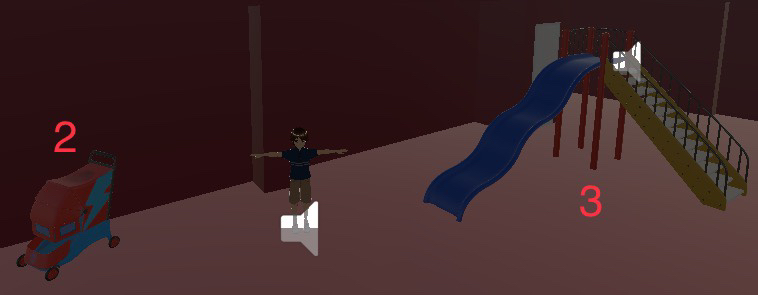
Objects on the second floor that have sound such as the Gregory VRoid and the playground.
Student-Made Models
The following list is of all of the models created by Silver Vo and Farah Kamleh. It should be noted that they have all been created in Blender and Unity. In the images of this section, the green numbers represent the student-made models.
- Ball Pit: Modeled by Silver, the ball pit serves as the fourth model larger than a human. It is also the first to use a lever that changes aspects of the scene. Pulling the lever changes Sundrop to Moondrop and triggers the first of two particle systems.
- Flashlight: Modeled by Farah, the duplicating flashlight has a light attached to it. It is the sixth of ten items that can be picked up and is the sixth of four models smaller than a human.
- Paper Cup: Modeled by Farah, the paper cup is the seventh of ten items that can be picked up and is the seventh of four models smaller than a human.
- Lever: Modeled by Silver, the lever is used to change aspects of the scene in two locations which are the ball pit and hidden stage.
- Prize Box: Modeled by Silver, the prize box is the fourth of four interactive objects in the scene that produce duplicates. Cranking the handle results in a Bonnie plush emerging as well as the second of two particle systems. It is also the eighth of four objects smaller than a human.
- Mr. Cupcake: Modeled by Farah, Mr Cupcake is a duplicating item that is the eighth of ten items that can be picked up. It is the ninth of four objects to be smaller than a human.
- Pizza: Modeled by Farah, the pizza is also a duplicating item that serves as the ninth of ten items that can be picked up. It is the tenth of four models smaller than a human.
- Charging Station: Modeled by Silver, the charging stations, which are the fifth of four objects larger than a human, allow the user to teleport to six locations in the scene.
- Stage: Modeled by Farah, the stage is based on the one found in Security Breach. It serves as the second of two objects with a lever that change aspects of the scene. Pulling the lever starts the theme music and turns on four lights. It also serves as the sixth of four objects larger than a human.
- Puppet Mask: Modeled by Silver, the puppet mask is the tenth of ten items that can be picked up and is the ninth of four models smaller than a human.
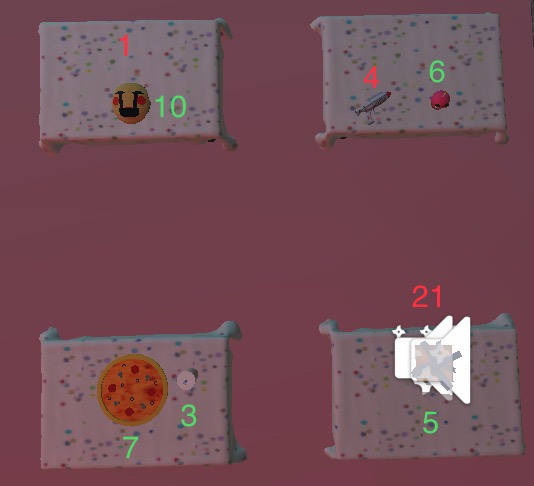
The four tables found near the front entrance that showcase some of the items that can be interacted with.
Additional Lighting
As required, more than four new lights have been added to the scene. One is attached to the duplicating flashlights. Four others are near DJ Music Man. One allows the blue thunderbolt on the charging station to glow. The last ones are five in total that are above the stage and its animatronics.
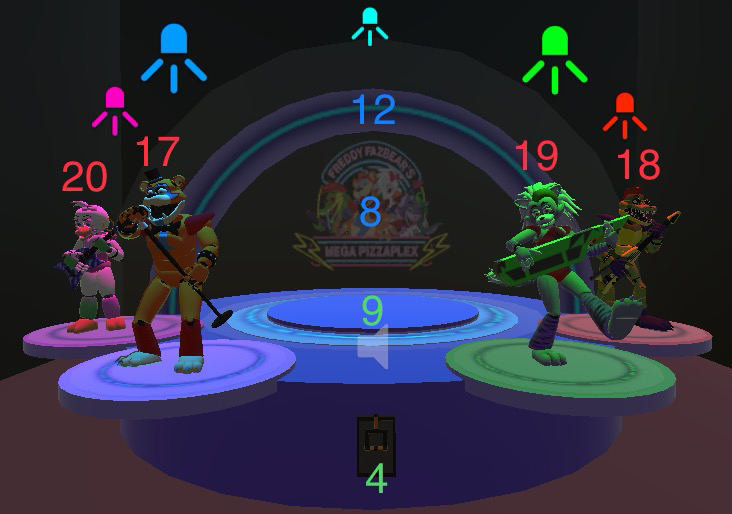
The stage found in the hidden room with its five lights.
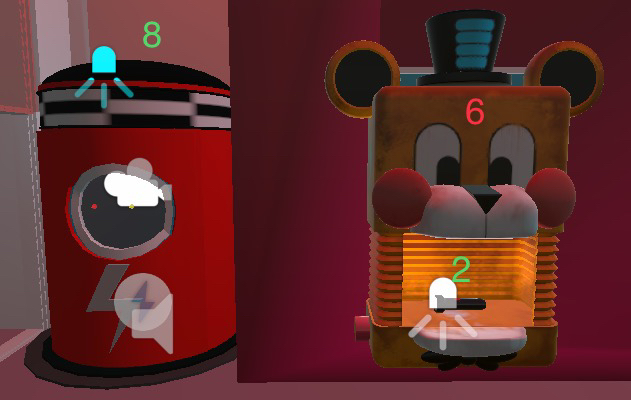
The lights associated with the Charging Station and Flashlight Charger.
Downloaded Assets - Flat Models
The following is a list of all the flat models that have been downloaded from the internet as well as their sources and credits. In the images, they are numbered in blue.
- Checkered Floor: https://en.wikipedia.org/wiki/Check_(pattern)
- Save Station Animation: https://www.youtube.com/watch?v=qXxKqMPE3_s
- Security Breach Logo: https://www.steelwoolstudios.com/five-nights-at-freddys-security-breach
- GF Banner: https://thefnafarchive.org/teasers/fullimg/205/
- MG Banner: https://thefnafarchive.org/teasers/fullimg/215/
- GC Banner: https://thefnafarchive.org/teasers/fullimg/216/
- RW Banner: https://thefnafarchive.org/teasers/fullimg/211/
- Mega Pizzaplex Logo: https://www.reddit.com/r/fivenightsatfreddys/comments/vi90ou/freddy_fazbears_mega_pizzaplex_logosign/
- Sundrop Poster: https://twitter.com/Popgoes6/status/1454582551029461001
- Moondrop Poster: https://twitter.com/Popgoes6/status/1454582551029461001
- Characters Poster: https://www.rockpapershotgun.com/five-nights-at-freddys-security-breach-is-out-now
- Neon Rings: https://www.pngarts.com/explore/248866
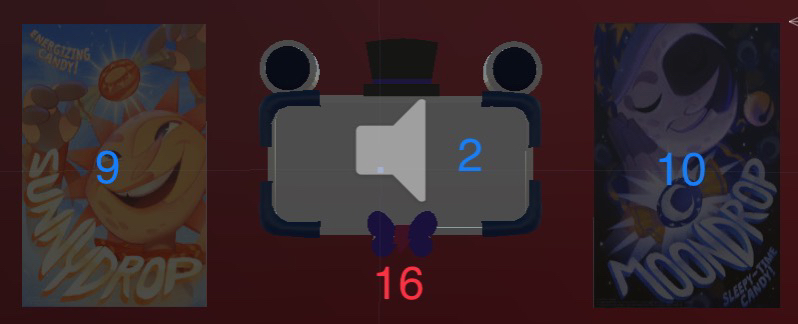
From left to right, the Sundrop poster, the Save Station, and the Moondrop poster.
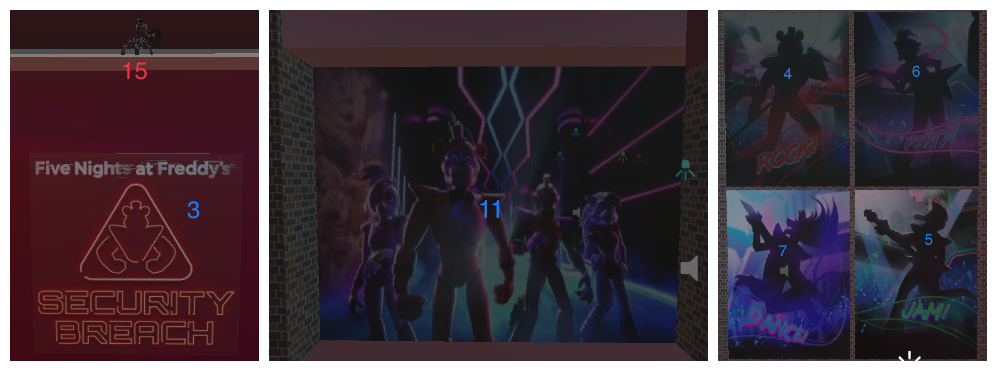
Some of the flat models used to decorate the building.
MakeHuman Models
Two human models have been added to the scene, each representing a character from Security Breach. Rather than using MakeHuman, an alternative, VRoid, was used. Modeled by Silver, the Vanessa VRoid, which can be found on the third floor near DJ Music Man, is modeled after the security guard Vanessa. When touched, she speaks a single line taken from the following video: https://www.youtube.com/watch?v=NlIX8ONKqbg . Modeled by Farah, the Gregory VRoid, which can be found on the second floor near the playground, is modeled after the playable protagonist Gregory. When touched, he speaks a single line taken from the following video: https://www.youtube.com/watch?v=mf8akm2vn5M . The animations for the characters are from Mixamo.

The VRoids were modeled after characters Vanessa, on the left, and Gregory, on the right.
Frame Rate
At highest, the frame rate is about 50; at lowest, it is about 30. The frame rate noticibly drops when an object, such as Mr. Cupcake, is duplicated many times. Similarly, the frame rate drops when staring at the first floor from a high distance like looking down from the third floor.
Discussion
Farah's Response
Developed at building-scale, this project demonstrates the potential of virtual reality as a method to propose and showcase a soon-to-be constructed building to, for example, employers and investors. For the sake of demonstration, suppose the Five Nights at Freddy's: Security Breach-themed building of the project is intended as the pitch. Through the use of a virtual reality headset, the individual can, right from the start, examine the scale of the building and its accompanying objects. It is clear from a quick glance that three floors are intended. The individual can explore the building by walking as they would in the actual building if it were real. However, to travel large distances, they would need to teleport using the green marker which is arguably a limitation of the application, but it should be noted that it is important for the physical safety of the user. However, if only being used for demonstrative and observational purposes, the virtual reality application serves well.
On the first floor, the individual can observe that a massive Golden Freddy statue surrounded by palm trees is intended to stand at a short distance from the entrance. Similarly, a kiosk, oven, and accompanying tables are also proposed in the same location. It can be argued that the interactive oven, for example, showcases to the individual how it intends to be used. By pressing the buttons, it creates duplicates of Mr. Cupcake and pizzas. In other words, the application is telling the user, "the oven will be used to serve students cupcakes and pizzas". The main takeaway from the objects placed on the first floor is that the space is intended as a "hangout" or lounge for students. Not only are visuals an advantage of virtual reality, but also audio. In the case of this project, there is an ambient sound of a buzzing fan. This sound indicates to the individual that, in the real building, a buzzing sound could be heard. Assuming that they are displeased by the sound, they can propose a fix prior to the development of the real building.
While the project showcases how a head-mounted display can successfully be used to showcase a building that is in development by "transporting" the individual inside of it, it would also be advantageous to deploy the project to a room-scale virtual reality display. Unlike head-mounted displays, room-scale displays encourage collaboration. By deploying the project to such a display, many individuals, rather than just one at a time, can explore the proposed building plan together. They can bounce ideas off of one another and express concerns to each other. This project showcases the way in which virtual reality, in general, can be used to generate a series of plans and designs prior to the final one. It is a time and cost-efficient method to developing, for example, a new vehicle or park attraction without having to spend time and money on real-world objects that will eventually be scrapped for better ideas. In addition, it can not only be shown, but also experienced in real-time by users whose input is vital to the project's development.
Silver's Response
This technology is great for demoing everything from a toy to a whole city. Since it can simulate being in a space in real time and you could see how big a door is going to be or how long a hallway is going to look like. You could also see how the structure would look from above, the sidewalks, from the inside etc. You can do research by asking participants or volunteers to put on the head set and navigate around to get their opinion on whether or not they find it enjoyable and if they can find things like elevators, bathrooms, stairs.
This technology has already been implemented worldwide as a way to demo a building, but before VR and AR came along it’s mostly restricted by only being on a screen, paper schematics. This is amazing because architects won’t have to meticulously build physical models to present to their clients anymore. They can go straight from building in software to AR display right on the table or put them in the actual building with VR. I know a couple of friends in architecture who take 20, 30 or even more hours building just their small house projects. Imagine the time it would take to painstakingly model the entire new building that we were working with in our third project; it would be close to hundreds of hours with or without extra help from other people. Now with this technology, you only need one person, supercharging them to be super efficient. Someone might bring up that the cost of these headphones is too high, but with the amount of time, work this technology cuts out of the workflow it would be well worth it. That’s why headsets like the Varjo XR3 are making a lot of impact to all of the industries that it’s used in. The industries that are going to use this technology will generally overlook the cost of it because they’re going to get more time saved, efficiency, less manpower, and best of all reusability. Usually models after they’re done with their purpose get torn down and thrown away, but with this, you can reuse the headset as many times as possible, wherever you want because you won’t have to carry around a physical model of your design.
There is another way you could use this technology in this matter, let say you have an empty plot of land and you want to design a house/building for it. Everyone can bring out an AR headset with the proposed model loaded on it and project it into the real world. They can walk around, in and out of the building, taking notes on what to improve or remove. Scale this up to an entire city, and it would make any project come to realization faster than ever before. The power of visualization is amazing and if we make use of it (which we already are to a certain extent) we can explode growth in all kinds of industries.